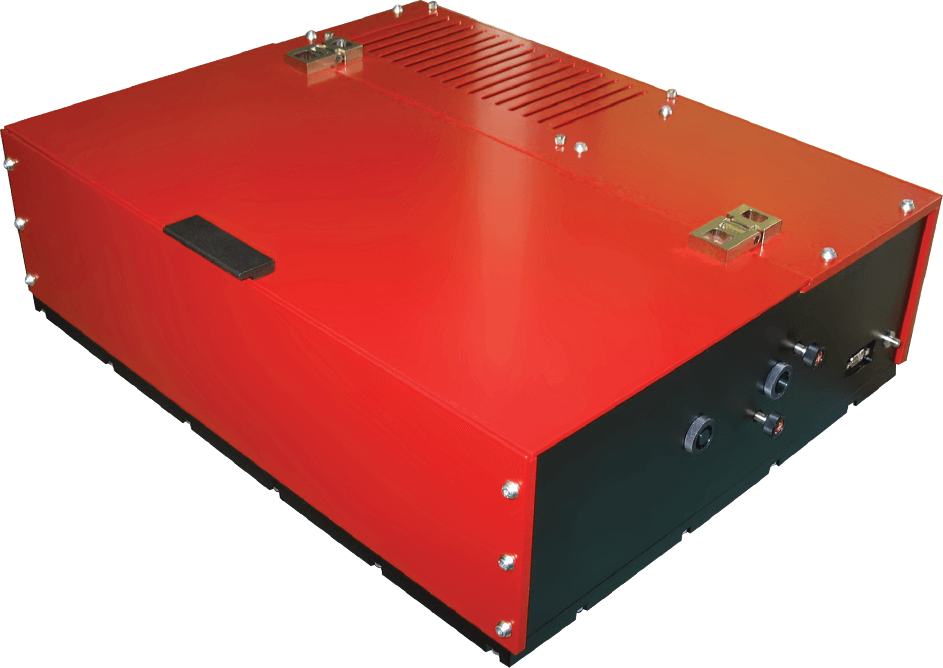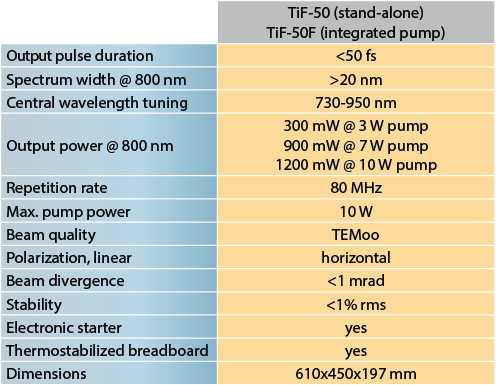Ti:Sapphire Femtosecond Laser TiF-50
Tuning range: 730-950 nm
Pulse duration: <50 fs
Output power up to 1.2 W (@10W pump laser)
Thermostabilized main breadboard
Motorized USB wavelength tuning
Electromagnetic starter
Tunable fs/CW switchable regimes (optional)

1. General
The TiF-50 laser system offers a balanced approach: less than 50-fs pulse duration over a broad tuning range. The unit is a flexible tool suitable for numerous applications and can really be a workhorse for many different projects going on simultaneously. The system can be supplied in two basic configurations: the TiF-50, being a stand-alone version for pumping with an external pump laser; or the TiF-50F system which may be integrated with an industry-standard pump laser on site or at our factory. However, the dimensions of the Ti:S laser head are the same for either version, the stand-alone version may later be fitted with an integrated pump laser at minimum additional cost. The acceptable pump laser power for the TiF-50/TiF-50F is up to 10 W. See tuning curves for output power vs. wavelength dependence.
The system also can be equipped with an optional birefringent filter and optional etalons providing narrowband tunable CW regime over the whole tuning range.
An external prism pair or a tunable pulse compressor (model APC) for dispersion pre-compensation is also available.
2. Specifications

3. Modifications
-PRE – adds a built-it pulse stretcher/compressor unit that allows introducing of up to -13000 fs^2 of negative dispersion to your setup to compensate for dispersion in different microscopes and home-built optical setups. Or you can always positively chirp your pulse for longer duration. See APC page for details.
-SP – built-in spectrometer (necessary for fully automated tuning).
-PW – adds a built-in power meter for average power monitoring via USB.
-TS – thermostabilized breadboard for improved stability in volatile environmental conditions.
-CW – provides possibility of wavelength tuning and narrow bandwidth (<2 GHz) in CW generation mode (other options for CW are also available, see TiC)
-CH – re-circulating chiller option
-PR – the TiF laser requires horizontally polarized pump. If you already own a vertically polarized pump, you can rotate its pol by using our optional pol rotator.
4. Applications
MPE microscopy
Nonlinear microscopy
Terahertz generation
OCT (optical coherent tomography)
Two-photon absorption structuring
“Pump-probe” spectroscopy
Material deposition
Material processing
Seed oscillator for amplifier systems
5. FAQ
Q. Do I need a chiller for proper laser operation?
A. Tap water supply may be used to stabilize the system, but in this case we cannot guarantee the quoted stability. We recommend purchasing the –CH chiller option (see below) or using an existing lab chiller. The 2 and 3 W systems may operate without any water circulation at all, but again with no stability guarantee. Under room temperature the systems do not produce much heat to dissipate; the chiller is mainly required for stabilization purposes. If the laser and the chiller are operated around room temperature, then <60 W heat dissipation capacity is required from the chiller unit.
Two connection tubes are provided with the laser.
Q. What is the wavelength coverage of a single set of mirrors?
A. If required, the unit is supplied with one mirror set and the standard coverage is 720-860 nm. However, one set of mirrors can cover any 150-nm wide part of the full 710-980 nm wavelength range, the standard sets in two-set package being 710-850 nm and 850-980 nm, but custom sets are available.
Q. Can we change the rep rate of the TiF system?
A. The rep rate is 80 MHz by default on all systems. On custom basis the systems can be factory-adjusted to any rep rate in the range of 75 to 125 MHz, but this rate is fixed. However, upon request we can set a few positions of the cavity mirror to cover several fixed rep rates (say, 80/100/120 MHz), but changing between them will require the user to re-align the laser cavity.
Q. Can we change the pulse duration of the TiF system?
A. The pulse duration is factory preset to 20 or 50 or 100 fs (or custom). However, the standard 50-fs and 100-fs systems are both typically capable of pulse durations from 35 to 100 fs depending on the alignment of the prisms that can be tweaked by the user if necessary and the wavelength. But if you do not feel like doing it the systems always come preset to the desired pulse duration.
We also can equip the system with an APC pulse stretcher/compressor so you can chirp or compress your pulse if necessary.
Q. Does the pulse duration of the TiF laser change with wavelength tuning?
A. Yes, the pulse duration changes a bit while the laser is being wavelength-tuned, but pulse duration never goes beyond the quoted value (<20, <50 or <100 fs), it only gets less sometimes. E. g. the TiF 50-fs version typically has 50-fs pulses at around 730 nm, 40 fs at 800 nm and 35 fs at 950 nm. However, if exact pulse duration is necessary at certain wavelength it can be obtained by adjusting the prisms while tuned to this wavelength.
Q. Is it possible to get CW radiation and CW wavelength tuning out of the TiF fs system?
A. Yes, it is possible to get CW radiation out of a standard TiF system, but it will not be wavelength tunable and the bandwidth will not be specified. However, with the option –CW we install an additional arm to the fs cavity, that comprises the birefringent Lyot filter that allows USB CW wavelength tuning and narrows the bandwidth to <40 GHz. Furthermore, we can install optional etalons narrowing down the bandwidth to <2 GHz. Please note that the CW and fs modes cannot operate simultaneously, but are simply switched by a flip mount.
Q.What is the –TS option for and what are volatile lab conditions?
A. The –TS option is a thermostabilized breadboard that is connected to a chiller (option -CH) to stabilize the whole laser system. Such stabilization might be necessary if the environmental conditions of the lab are quite volatile. Under such conditions we mean no aircon or temperature changes over ±2° during the 8-hour period, air flow right over the optical surface, poor vibration protection, substantial amounts of dust.
Q. What equipment might be required to work with a fs Ti:S laser?
A. Here is the list of components that are not absolutely necessary, but might be very handy while working with a Ti:S femtosecond laser upon different experiments:
1. Power meter for control of output power value (or option –PW)
2. Interferometric autocorrelator for measurement of pulse duration with time resolution better than 10 fs. We offer our AA-10DD and AA-M autocorrelators.
3. Fast photodiode with 400 MHz oscilloscope to display the temporal structure of output radiation (the fast photodiode is built into the TiF’s electronic starter).
4. A photodiode with >10 mm^2 sensitive area or low-inertial power meter for fast control of relative output power in the process of alignment
5. During the alignment of the laser you may need two polarizers, we recommend polarization cubes or Glan laser prisms
6. Spectrometer or diffractive grating operating near 800 nm for spectrum control (or our –SP option)
7. Infrared sensor card for observation of weak IR luminescence
8. Infrared viewer
9. Dry nitrogen supply for purging the water vapor from the laser head for damp environment and some ultra-precise experiments at 960-980 nm
10. A chiller to keep the Ti:sapphire rod at a constant temperature for performance stability (option –CH). At least tap water source is required
6. RFQ Hints
Just some quick hints before you send us an RFQ:
1. Choose the right optical scheme for you – TiF (longer) or TiF>-M/TiF-F (compact) designs
2. Decide on whether you require a pump laser together with the system and select the pump power. Remember that tuning range and Ti:S output average power greatly depend on the pump level. See tuning curves for details.
3. Decide if you need full wavelength coverage or one central set of mirrors will do the job (720-860 nm). Also see tuning curves for possible wavelength coverage at different pump levels.
4. Equip your system with modifications if necessary. See the Modifications tab.